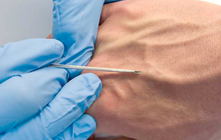Targeted Temperature Management Trial: Is it Time to Stop Cooling Patients after Cardiac Arrest?6/1/2014
 In 2002 two published articles in the New England Journal of Medicine changed ICU management of out of hospital arrests profoundly. According to these two articles (cited below) the American Heart Association labeled this to be good evidence (Level1) to recommend induced hypothermia in comatose survivors of out of hospital cardia arrest caused by VF. The target temperature was recommended to be between 32-34°C and to be maintained for 12-24 hours. And now this... Nielsen et al. present the Targeted Temperature Management Trial showing, that there is NO difference between patients cooled to 33°C and patients kept at 36°C. Is this the end of the cooling era, should we change our management? I personally think think that this trial basically adds up to our knowledge in the field of post cardiac arrest care, but not necessarily contradicts the previous two trials. We now have one trial showing that there seems to be no difference between 33°C and 36°C but we also know, that hyperthermia (pyrexia) is troublesome and associated with worse neurological outcome. So, as pronounced hypothermia (33°C) makes no difference to ‘mild’ hypothermia (36°C) and pyrexia is proven to be harmful... the question is: What is the right temperature? We seem to head towards normothermia or mild hypothermia in order to provide best management for our patients. It’s going to be interesting to see how recommendations will change in the near future. The Targeted Temperature Management Trial: Nielsen N, et al. New Engl J Med. 2013 Dec;369(23):2197-206 The 2 trials that introduced therapeutic hypothermia into ICU practice: The Hypothermia After Cardiac Arrest Study Group, Holzer at al. New Engl J Med. 2002 Feb;346(8):549-556 Bernard S.A. et al. New Engl J Med. 2002 Feb;346(8):557-563 Review article on therapeutic hypothermia for non-VF/VT cardiac arrest: Sandroni S. et al. Crit Care Med; 2013;17:215 Pyrexia and neurological outcome: Leary M. et al. Resuscitation. 2013 Aug;84(8):1056-61  The importance of a positive family history for the predisposition to coronary heart disease and myocardial infarction is well established. Erdmann J. et al. describe in their just published Nature article how two seperate mutations in two functional relates genes directly lead to accelerated thrombus formation in the microcirculation. The mutations have been found in a large german family out of which 23 had suffered of a myocardial infarction. Is the answer for further improvement in the treatment of myocardial infarctions maybe in our genes...? Erdmann J. et al. Nature, November 2013; nature 12722  Inspired by an excellent post by Dr. Pat Nelligan on AnaesthesiaWest we would like to provide even more evidence against routine change of IV catheters... just because you are told to do so for hospital policy reasons. Brown D. et al. have provided an excellent overview article on this issue. It is clearly shown that peripheral IV catheter should be replaced as clinically indicated, rather than on a routine basis. The level of evidence here is: A. This means that this recommendation of this treatment/ procedure is effective! We add another 3 articles supporting this recommendation. We do many other things on ICU with lower levels of evidence, or even no evidence at all. So it is definitely time to change this bad habit. So Pat, I won’t do it either... full stop! Bregenzer T, et al. Arch Intern Med, January 1998; 158(2):151-6 Lee WL, et al. Am J Infect Control, 2009 Oct;37(8):683-6 Lai KK, et al. Am J Infect Control, 1998 Feb;26(1):66-70 Dopamine has been widely used in the past for improving renal function but was abandoned due to lack of evidence and various potential serious side effects. In the new Heart Failure Guidelines 2013 of the AHA.pdf there is an interesting note in the section hospitalized patients with heart failure: low-dose dopamine infusion may be considered in addition to loop diuretic therapy to improve diuresis and better improve renal function. The level of evidence is IIb/B which means that efficacy is less well established and that there is greater conflicting evidence from trials. Indeed, when looking at the cited articles more questions than answer remain... but see yourself.
Giamouzis G, et al. .J Card Fail. 2010 Dec;16(12):922-30 Elkayam U, et al. Circulation. 2008 Jan 15;117(2):200-205 |
Search
|


 RSS Feed
RSS Feed


